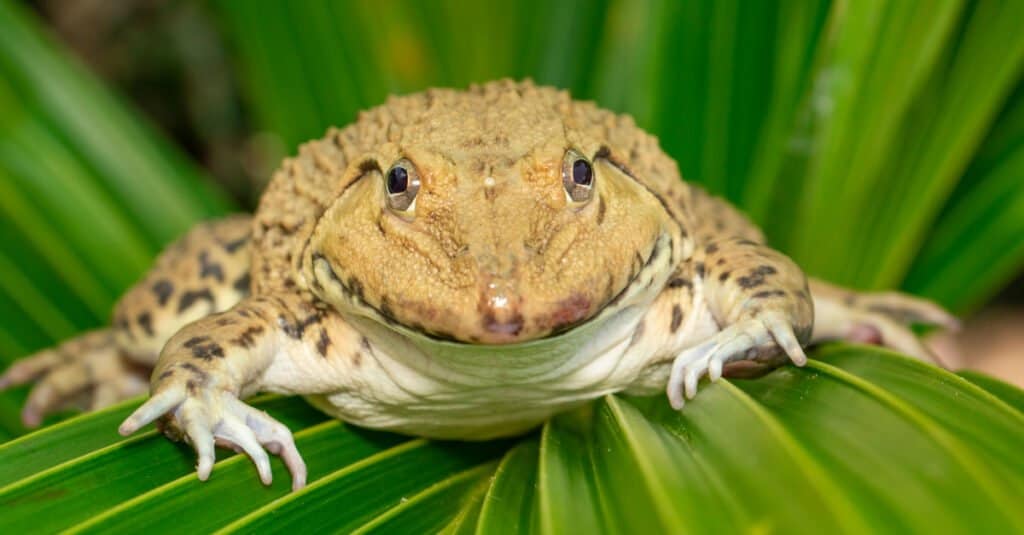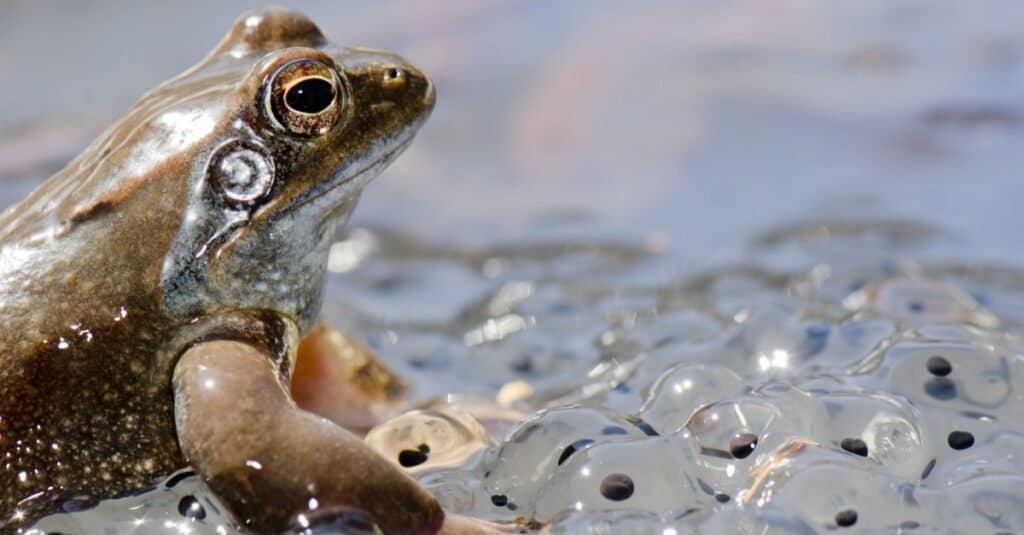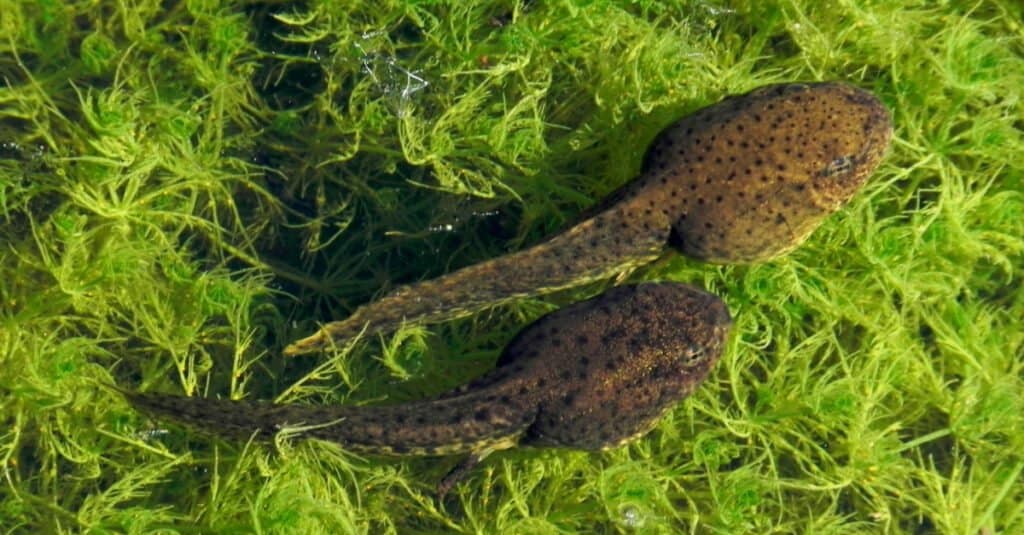Reproduction is necessary for any animal species to exist, and amphibians such as frogs are no different! But how do frogs reproduce and make more of themselves? How does their life cycle play out? Can frogs give live birth, or do they only lay eggs? It turns out, the answers to these questions are a bit more complicated than most would initially believe.
Learn more below about the usual–and unusual–methods frogs use to reproduce. Whether you’re just curious, own pet frogs yourself, or work with them in some capacity, learning about frogs’ life cycles can be both interesting and useful!
Do Frogs Reproduce Sexually or Asexually?

All species of frogs reproduce sexually.
©yod 67/Shutterstock.com
All frogs reproduce sexually–there are no known species of asexual frogs. However, whether they use internal or external fertilization to fertilize their eggs depends on their species.
Most frogs use external fertilization, in which a female and male release their eggs and sperm around the same time. A handful of species use internal fertilization instead. In that case, a male will fertilize a female’s eggs internally, and then the female lays the fertilized eggs later around when they’ve finished developing.
Female frogs can produce thousands of eggs per year! They retain them in their bodies until it’s time to mate. If she doesn’t mate with a male and her eggs don’t get fertilized, they die off inside her body.
Most frogs seek out mates sometime in spring or summer once per year. They will typically gather in large numbers in a very moist environment and find a mate to engage in amplexus with. Amplexus involves a male and female frog clinging tightly to one another’s bodies for many hours or even days at a time! At some point, the male frog will release sperm from his cloaca and either fertilize the female’s eggs internally or externally. Afterward, the two frogs will release and go their separate ways.
After a female frog’s eggs have been fertilized, they will develop inside of her body for a certain period of time. In most species, the female frogs will lay their eggs in a moist environment where they will continue to develop for anywhere from a few days to a few weeks before they hatch. However, a handful of other species’ eggs develop inside the female’s body! In that case, she will give live birth to either froglets or tadpoles after the eggs hatch inside her body.
Do Any Frogs Give Live Birth?

Live birth is rare amongst frogs; most hatch from eggs.
©iStock.com/Suwatwongkham
The vast majority of frogs lay eggs, but some species that use internal fertilization do give live birth to froglets. Interestingly, of all the species of frogs that give live birth, only one species, L. larvaepartus, gives live birth to tadpoles–the rest give birth to froglets.
Overall, live birth is fairly rare amongst frogs, but it is not completely unheard of!
In order for a frog to give live birth, a male must fertilize a female’s eggs internally. After they are fertilized by a male’s sperm, the eggs will develop inside her body until they hatch. Not all species that use internal fertilization give live birth–many still lay eggs! Currently, there are 13 known species of frogs within the Nectophrynoides genus that give birth to live froglets.
Additionally, there is one species that gives birth to tadpoles instead: Limnonectes larvaepartus, which researchers discovered in 2015 in Indonesia’s rainforests.
Unusual Methods of Reproduction in Frogs

Most frogs lay their eggs in water, but some species use more unconventional methods.
©Marco Maggesi/Shutterstock.com
While the vast majority of frogs either lay eggs or give live birth in a fairly standard manner, there are a few notable anomalies and variations. These include the Surinam toad, whose babies burst out of eggs on the females’ backs, and the now-extinct gastric-brooding frogs, which incubated their eggs inside their stomachs!
Perhaps the most unusual method of reproduction amongst frogs involves the Surinam toad, Pipa pipa. When a male Surinam toad locates a female, he will attach to her in typical amplexus fashion. The female and male toads will release their sperm and eggs at the same time, resulting in external fertilization.
This is where things get weird! After the male fertilizes the female’s eggs, he will push them onto her back, where they will stick to her body. Soon after, she will grow a protective layer of skin over the eggs on her back. The eggs then develop while attached to her until it’s time to hatch! In a grotesque yet fascinating event, the babies burst out of the female’s back.
Additionally, platypus frogs, which unfortunately went extinct in the 1980s, reproduced in a very unusual way. Only two species existed within the genus, and both were native to Queensland, Australia. Although the species fertilized their eggs normally via external fertilization, the way in which the species incubated them was truly bizarre.
After laying her eggs and having them fertilized by a male, the female would swallow them! The eggs would then secrete a protective layer of mucus so they wouldn’t be digested by their mother’s stomach. Finally, once the eggs hatched into tadpoles, their mother would regurgitate them. The tadpoles would safely swim off to repeat the process all over again!
How Many Stages Are in a Frog’s Life Cycle?

Frogs typically begin life as tadpoles, but some species skip this stage entirely!
©Joshua Ouellette/Shutterstock.com
There are generally either three or four stages of a frog’s life cycle, depending on their species. In order, these stages are: egg, tadpole, froglet, and frog. Some species bypass the tadpole stage altogether and are born as froglets.
The vast majority of frog species undergo all four distinct life stages. However, some species, including many that use internal fertilization, bypass the tadpole stage entirely! In this case, instead of laying her eggs, the female will retain them and allow them to develop inside her body. She will eventually give birth to live froglets when her eggs have finished developing.
Alternatively, some species that skip the tadpole stage, like the Coqui frog, lay their eggs on land rather than in water. Since these frogs’ young start their lives on land, they begin their lives as froglets with limbs rather than tadpoles.
The photo featured at the top of this post is © iStock.com/Suwatwongkham
Thank you for reading! Have some feedback for us? Contact the AZ Animals editorial team.






